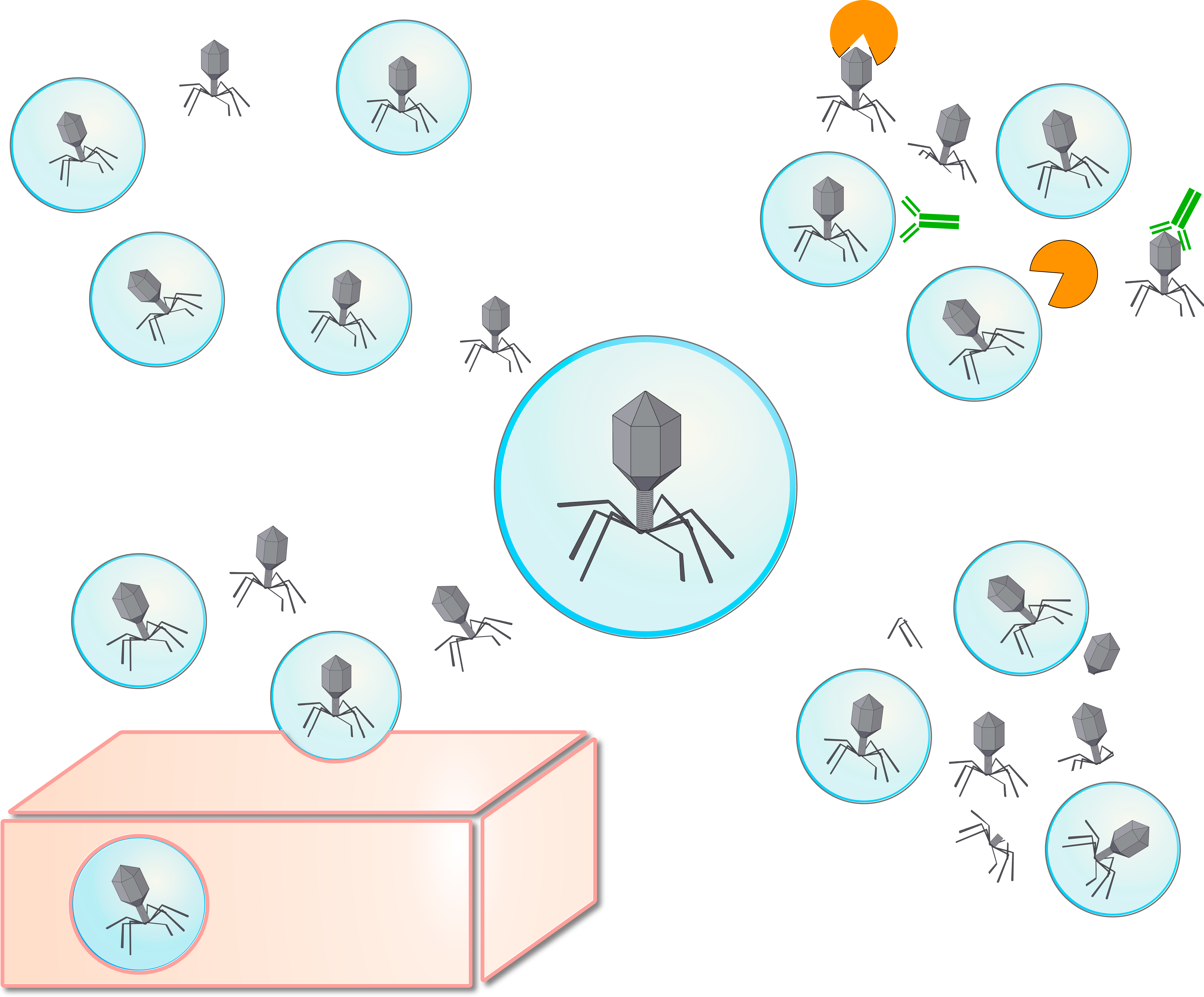Battling Drug Resistant Bacteria with Bacteriophages
17 February 2023
Phage therapy and nanotechnology could be used for the effective diagnosis and treatment of multidrug-resistant bacterial infections
Bacterial infections greatly threaten human health and burden healthcare systems worldwide. With newer strains of bacteria showing resistance against an increasing amount of antibiotics, treating these infections poses a challenge for healthcare personnel. However, a new ray of hope has shone in the form of bacteriophages and nanoparticles, which can be used to detect and destroy or inactivate bacteria. A new review article discusses the same.
The overuse of antibiotics over extended periods of time has led to the emergence of multidrug-resistant (MDR) bacteria in recent years. This poses a significant threat to public health, with more than 1.2 million deaths caused due to MDR bacteria. Moreover, progress in the research & development of new antibiotics has slowed down; most of the ‘new’ antibiotics are modifications of prior existing drugs, with only a handful of novel chemical formulations being produced.
There is, however, hope in the form of tiny organism called bacteriophages. These viruses specifically infect bacteria, and therefore, represent a viable alternative against MDR bacteria, Phage therapy could also help avoid side-effects like dysbiosis (the disturbance of our own body’s “good bacteria” by antibiotics), and is ecologically friendly. However, their species specificity is a double-edged sword, and may pose potential roadblocks to the clinical application of bacteriophages, coupled with their low bioavailability, and the risk of infectivity loss.
But phage therapy is a work in progress, and to overcome these obstacles, alternative combinations are being explored. Nanotechnology has now emerged as a viable adjunct to phage therapy, and this review, which appeared online on 4 January 2023, and was published in Volume 5 of the Biodesign Research journal on 16 January 2023, aims to gather research on biosensors and antibiotic therapy that employs both nanoparticles (NPs) and bacteriophages to detect and kill or deactivate bacteria.
The corresponding author of this paper, Dr. Pilar Domingo-Calap from the Institute for Integrative Systems Biology in Spain, tells us more. “Gold and/or silver NPs can bind to bacteria and phages, facilitate the former’s detection and the diagnosis of bacterial infection. These NPs can be detected via colorimetric, spectrometric, or electrochemical means. These NPs could also be attached to recognition elements such as aptamers, antibodies, enzymes, and DNA fragments, which facilitate a more efficient recognition and binding to bacteria and bacteriophages.” So far, these have successfully been used to detect bacteria like Escherichia coli, Pseudomonas aeruginosa, Vibrio cholerae, and Xanthomonas campestris. What’s more, approaches employing these NPs are easy to operate and store, quick, and portable, highlighting their diagnostic potential.
NPs can also work in sync with bacteriophages to kill bacteria, via photothermal therapy (PTT), which involves the release of heat, or photodynamic therapy, which involves the release of heat or reactive oxygen species. While the formation of bacterial biofilms deters this process by reducing the penetration capacity of the NPs, the use of enzymes to disrupt these structures is being explored, with DNAase showing promise. A combination of this enzyme with gold NPs has shown success in disrupting biofilms and killing bacterial strains such as Staphylococcus aureus, Staphylococcus epidermidis, E. coli, and P. aeruginosa through PTT/PDT. Several phage-NP combinations are also being tested, with a M13 phage-gold nanorod (‘Phanorod’) formulation showing promise. However, further in vivo studies are needed to ensure that these formulations have no immunological side-effects.
Dr. Domingo-Calap also discusses another avenue to improve phage therapy “Encapsulation of phages can reduce the elimination of bacteriophages, ensure their controlled release, and thus, ensure a steady supply of therapeutic against infection.”
The phages can be encapsulated in polymers, which are macromolecular structures with a large surface area-to-volume ratio, enabling their efficient loading and delivery. However, these polymers may also decrease the effectiveness of the treatment. They can, however, be synthetically generated, which allows better control on their properties. Polymer-encapsulated phages have shown to be highly effective against pulmonary infections caused by P. aeruginosa in subjects suffering from cystic fibrosis. This technology also has far-reaching implications for the eventual development of phage-based vaccines. However, the authors reiterate the importance of selecting an appropriate solvent during the synthesis of these polymers, as organic solvents are known to inactivate phage particles, reducing the effectiveness of the therapeutic.
There is also a growing interest in lipid-based structures for the encapsulation and delivery of phages. Liposomes, which are double-layered phospholipids enclosed in an aqueous cavity, can be synthesized by a variety of techniques. Their small size allows for adherence to mucous-rich surfaces, as well as uptake by phagocytic cells, allowing them to reach intracellular pathogens such as Mycobacterium tuberculosis, Listeria spp., Salmonella spp., and Staphylococcus spp. Liposomes composed of cholesterol or polyethylene glycol (PEG) have proven effective in phage-mediated treatment of gastrointestinal infections, facilitating effective diffusion and bioavailability to different tissues, as well as protection of the phage particles from the host immune system. However, an important limitation that is highlighted by them is the small size of the liposomes, which restricts the type of phage that can be encapsulated, depending on its size.
Dr. Domingo-Calap concludes by surmising, “Phage-based nanotechnology can be a very promising and efficient alternative to overcoming antimicrobial resistance. It can be exploited in prevention, diagnosis, and treatment of bacterial diseases. Although there is still a long way to go, especially at the regulatory level, phage-based nanotechnology is in the spotlight and future research in the field will improve the development of new antimicrobial products.”
Reference
| Title of original paper | Phages and Nanotechnology: New Insights against Multidrug-Resistant Bacteria |
| DOI | 10.34133/bdr.0004 |
| Journal | BioDesign Research |
| Authors: | Marco Pardo-Freire and Pilar Domingo-Calap |
| Affiliations | Institute for Integrative Systems Biology, I2SysBio, Universitat de València-CSIC, 46980 Paterna, Spain. |
Additional information for EurekAlert
| Publication Date | 16 January 2023 |
| Method of research | Literature review |
| Subject of research | Not applicable |
| COI statement | The authors declare that they have no competing interests |
Email of corresponding author: pilar.domingo@uv.es

Image Title: Properties of encapsulated phages that may improve phage therapy.
Image Caption: (A) Controlled and prolonged release over time. (B) Protection against conditions that may inactivate phages such as acidic pH, neutralizing antibodies (green), and enzymes (orange). (C) Higher adhesion permeability and diffusion into tissues as compared to free phages by the interaction of the particle with the tissue. (D) Higher stability of phage particles during storage or administration as compared to free phages.
Image Credit: Pilar Domingo-Calap, Institute for Integrative Systems Biology, Spain
Image link:https://spj.science.org/doi/full/10.34133/bdr.0004
License Type: CC BY 4.0


